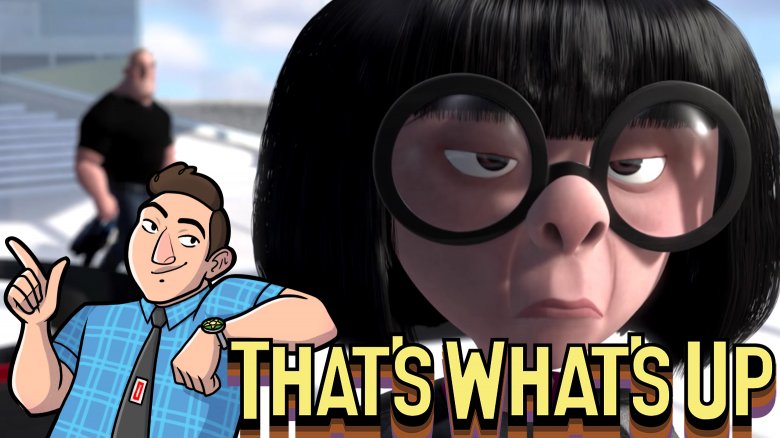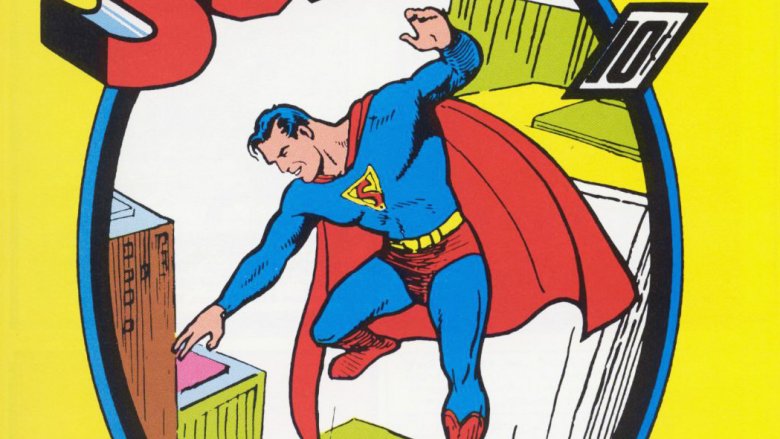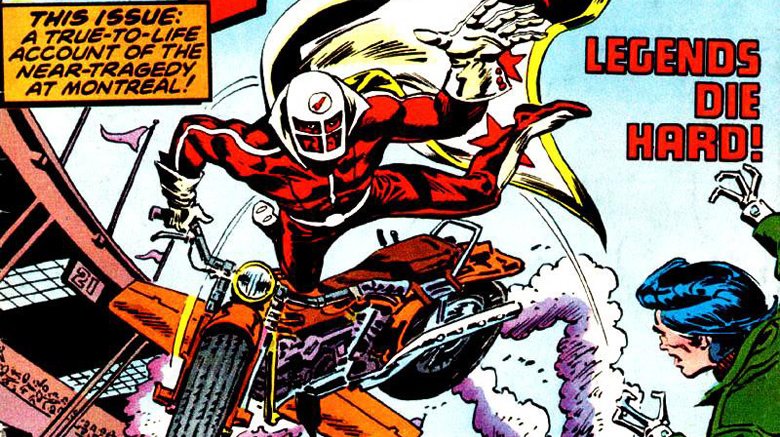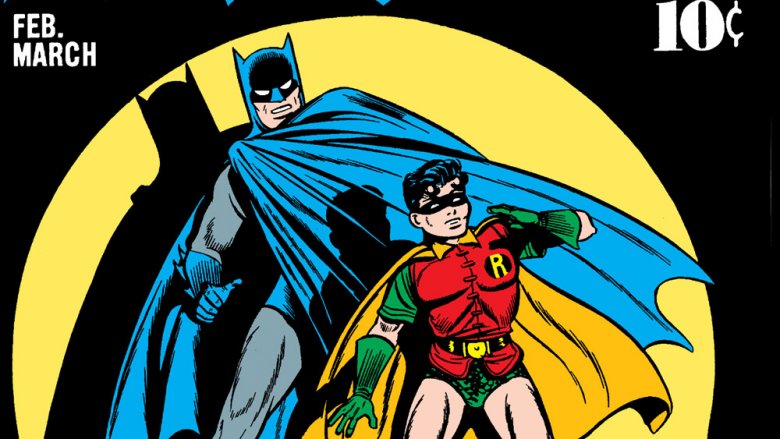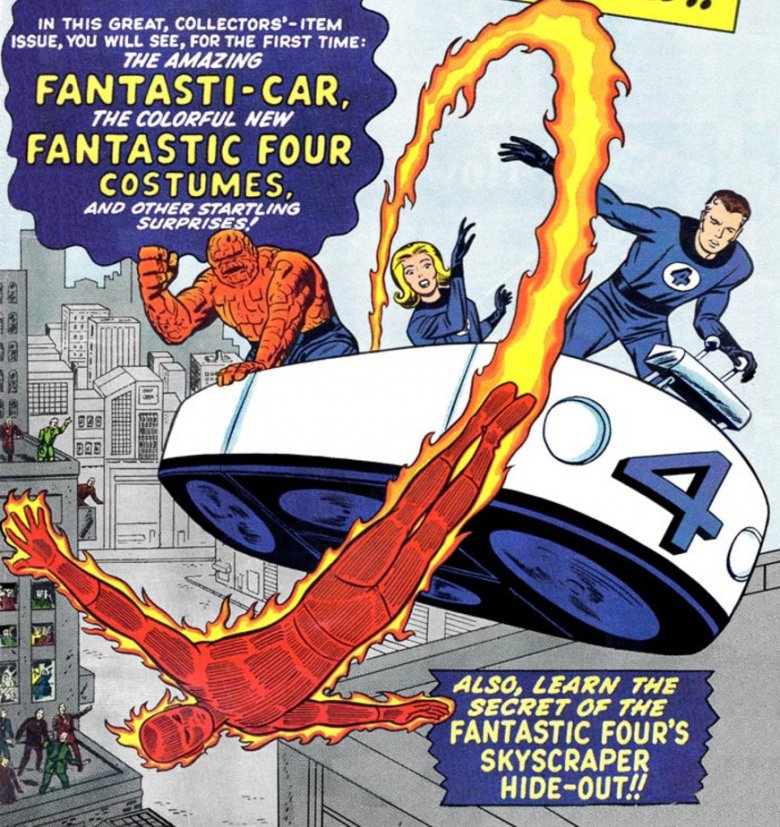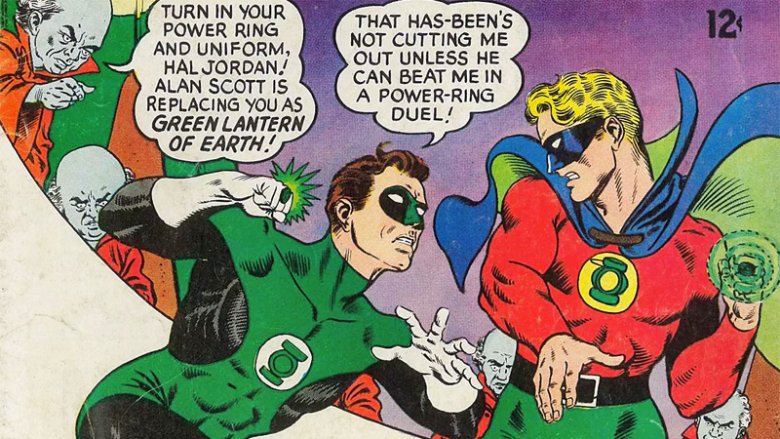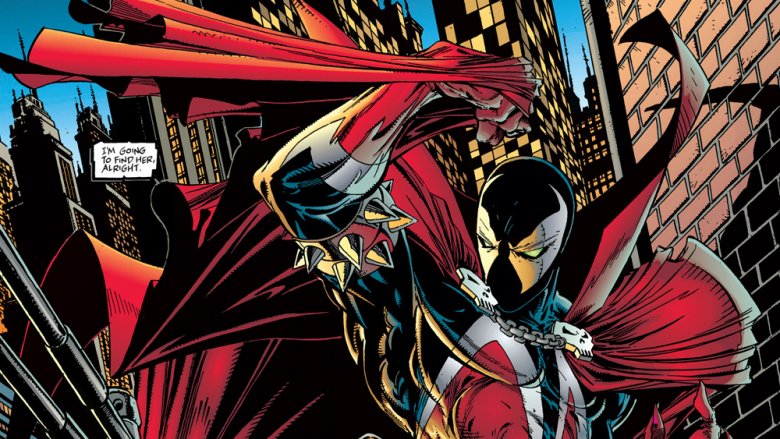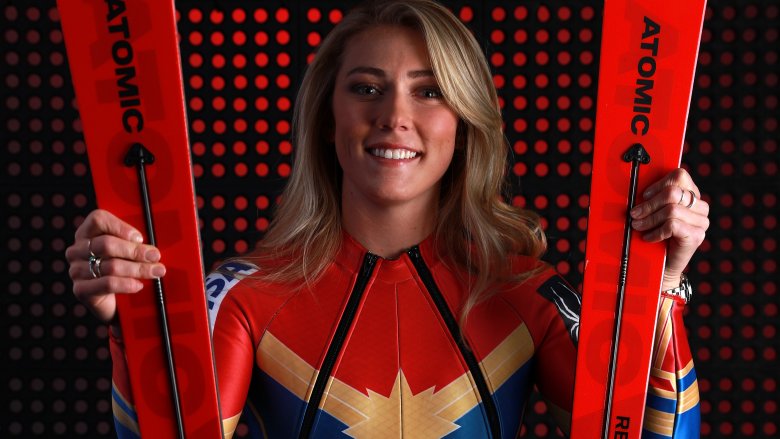That's What's Up: Is The Cape Dead For Superhero Costumes?
Each week, comic book writer Chris Sims answers the burning questions you have about the world of comics and pop culture: what's up with that? If you'd like to ask Chris a question, please send it to @theisb on Twitter with the hashtag #WhatsUpChris, or email it to staff@looper.com with the subject line "That's What's Up."
Q: For superheroes, is the cape dead as a design choice? What killed them? Could they come back? — @kingofdoma
Back when The Incredibles came out, I was working the front counter at a comic book store, and let me tell you, there was good news and bad news. The good news, of course, was that we were all pretty stoked about getting what was arguably the single greatest superhero movie we'd ever had up to that point, but the bad news was that every time I had a conversation about superhero costumes, I had someone doing their impression of Edna Mode shouting "no capes!" while I was contractually obligated to listen. And it will not shock you to learn that I have a lot of conversations about superhero costumes.
But if we can put aside Brad Bird's sartorial edicts for a moment, I'm going to take the bold stance that capes on superhero costumes are actually pretty great, even if they're not for everyone.
Superman's cape: no tugging
Like a lot of things codified into the visual language of superheroes, the cape comes pretty directly from Superman. The thing is, Jerry Siegel and Joe Shuster didn't just pluck it out of mid-air as a fashion accessory. Instead, they synthesized that costume from a bunch of different sources, cobbling together bits of iconography that worked so well they'd pretty much redefine what the word "hero" meant for the next century.
Along with those red trunks — probably the second-most discussed article of clothing in comic book history — the cape was likely picked up pretty directly from circus strongmen. You know, the guys who wore tights and performed amazing feats of strength, and would've had a prominent visual language in the era before television thanks to their role in traveling carnivals during the Depression? That's the easiest connection to make, but it's definitely not the only one. The immediate predecessors to the superhero genre were also known to occasionally rock capes as part of their costumes. The Shadow had one — we'll get back to him in a second — and the Scarlet Pimpernel, the character who forms one third of the triangle that Bob Kane and Bill Finger were riffing on when they created Batman, was often depicted wearing a short riding cloak.
But even beyond fictional characters, there's a long tradition of capes as a visual signifier for, well, theatrical majesty — or possibly majestic theatricality, depending on which part you want to emphasize. You can see them as part of clerical vestments in the form of the ferraiolo, and as you might've noticed if you've watched The Crown, they're part of the garb that royalty wear for their big ceremonial events.
Fashion in motion
It goes beyond all that lofty stuff, though. I mean, Evel Knievel wore a cape, and so did the Human Fly, a masked Canadian stuntman with an actual real life secret identity who wound up starring in a 19-issue Marvel Comic billing him as "the wildest superhero of all — because he's real!" I'm not really sure how they got away with that one when he was teaming up with Spider-Man and Ghost Rider, a straight up demon from hell who rode a motorcycle made of fire, but, well, 1978 was a wild time and today's not the day for dealing with that one.
Anyway, while Queen Elizabeth II and Evel Knievel aren't usually the kind of people you think of having a whole lot in common, the capes are all meant to evoke that same sense of grandeur. And honestly, while DC has tried to give Clark Kent a bit of regality over the years, Knievel's cape — and those found on circus performers, stage magicians, and acrobats before him — is more closely linked to Superman's for one simple reason. They make it look a lot cooler when you're flying through the air.
Unlike a lot of Golden Age greats, Joe Shuster didn't have a lot of formal art training. In fact, in a 1992 interview with the Toronto Star, he mentioned that his first few submissions to DC were drawn on the backs of wallpaper rolls he'd scrounged up from a construction site. He was, however, certainly perceptive enough to realize that having that cape billowing out behind this brand new character he and Jerry Siegel were creating would give a sense of motion and action to the panels where he was leaping over tall buildings in a single bound.
Shadow of the Bat
For Batman, the origins of the cape are actually a little different. Of all the ridiculous, self-aggrandizing lies that Bob Kane told about the creation of Batman over the years — including lying about his age when he signed his contract with National and potentially faking a sketch to "prove" that he came up with the Dark Knight all by his lonesome — the one that I actually do believe is that he was inspired by Leonardo Da Vinci's design for a flying machine when he came up with Batman's cape. The cape was, after all, the only thing from that original design that made it into the final character. Literally everything else came from Bill Finger.
Either way, it was a good look. Finger and Kane were definitely riffing on the Shadow when they came up with those first few stories, and Batman's cape allowed him to literally cast a bat-shaped shadow to terrify his enemies. Also, in the same way that the Shadow's black cape was often depicted as being linked to the blood-red scarf that hid his face on the covers of those old pulp novels, Batman quickly developed the tendency to pull the cape around his face, giving him that mysterious look that worked so well for what was nominally supposed to be a comic about detectives.
With those two characters at the foundation of the genre, it's no wonder that the idea of a cape became synonymous with superheroes. There were certainly other major characters who didn't follow the same pattern — Wonder Woman and Captain America are the two big ones who spring to mind, and the Golden Age Flash oped for the metal helmet inspired by Mercury rather than a cape to indicate his mythological grandeur — but if we're being honest, none of them had Superman's pop cultural impact in terms of defining the look. He was the character who defined the genre, and so much of the visual language around them comes directly from him.
The tights, the trunks, the big iconic emblem emblazoned across his chest, all of those things became so symbolic of the genre that you still see them linked together in the zeitgeist 80 years later. How many times have you seen "not all heroes wear capes," or seen the word itself used as a shorthand for the genre? I've seen Wonder Woman socks that come with little capes attached, even though Wonder Woman does not actually wear a cape. It's the look for superheroes.
Or at least it was, until it suddenly wasn't anymore.
No capes!
I wrote about something similar not too long ago with regards to what happened to the idea of a kid sidekick, another element of superheroes that remained synonymous with the genre long after it had fallen out of favor in the actual comics. Much like that phenomenon, I think you can put a good portion of the blame onto Marvel Comics for putting the nail in the caped coffin, as it were. There were a couple of characters in that original Marvel roster who had them, of course. Thor had one, and Doctor Strange's famous Cloak of Levitation helped to give him that weirdo wizard look that was so popular on black-light posters in the '70s, but beyond them and maybe two or three others, that's about it. The rest of their major heroes, from Spider-Man to Captain America to Iron Man to the Fantastic Four? Not a cape to be found on the lot of 'em. The villains, however, were all about accessorizing with a few extra yards of cloth.
That's where you'll find capes in the Marvel Universe: on characters like Magneto, Mysterio, and Doctor Doom. There's a simple reason for that, too: in the Marvel Universe, where the comics are built on the ideas of flawed everymen like Peter Parker and Ben Grimm having to deal with the great responsibility that comes from their great powers, majestic theatricality isn't a heroic ideal. It's the villains who are devoted to that sort of over-the-top bombast.
It's something that you can see in the DC Universe too, with characters like, say, Count Vertigo, but with Marvel, there's a really hard and fast dividing line between the blue-collar heroes and everyone else. If you're one of the good guys, you can only get a cape by having a level of cosmic importance, like being the literal god of thunder or the Sorcerer Supreme. If you're a bad guy, all you really need is to just hate Reed Richards so much you can't stand it.
The caped and the capeless
At the same time, you can't really put all the blame on Marvel for this one. By the time the Fantastic Four got their bright blue unstable molecule suits — which would in turn inspire the Incredibles and their famously capeless costumes — even DC's heroes had started moving away from capes. Characters like Aquaman and Green Arrow never had them to begin with, because capes don't really work underwater and because Oliver Queen always strives for accuracy with his Robin Hood cosplay, respectively. When Barry Allen arrived as the all-new, mostly different Flash in 1954, however, he kicked off a trend of reimagining older heroes with more streamlined costumes.
The Golden Age versions of Green Lantern and the Atom had capes, but their successors, Hal Jordan and Ray Palmer, shed them in favor of sleeker suits. Heck, depending on how long a timeline you want to look at, you could say the same for almost every other Golden Age hero who wore a cape. Dr. Fate would be the one who hung onto it the longest, but by the '90s, he'd been replaced by the hilariously extra Jared Stevens ("The Man Called FATE!"), and Starman would go through multiple cape-free redesigns until he was just hanging out in a leather jacket and jeans in 1994. The Sandman, whose original pulp-inspired costume just added a purple cape to a green suit and gask mask, ditched it for a capeless but more superheroic look in 1942, then got one back when he was reimagined as a nightmare warrior who fought "weirdies" in 1974, and then lost it again when he was re-reimagined by Neil Gaiman and Sam Keith as the cosmic embodiment of dreams in 1989.
There's a pretty interesting reason why, too. In the larger world of pop culture, Superman's iconic look has made the cape and tights synonymous with the word "superhero." In comics, though, where superheroes are the standard, with infinite variations on the theme, a cape just makes you look like Superman. Creators like Stan Lee and Jack Kirby at Marvel and John Broome, Gil Kane, and Gardner Fox at DC were undoubtedly trying to win readers over by promising something new and different that went beyond those core two characters. By removing the cape, they gave readers a visual signifier that they were dealing with a new kind of hero, and the clean-lined aesthetic of the jet-age '50s and '60s led pretty directly to those one-piece costumes that you see on Green Lantern and Flash.
The exception, of course, being the Martian Manhunter, who apparently decided to distinguish himself by showing up in 1955 wearing only a cape and trunks. Say what you will, but it's certainly A Look.
'Give me all the cape you have.'
Point being, giving a new hero a cape today — or 20, 30, even 50 years ago — didn't just tie them to the superhero genre. It didn't need to. The fact that they were existing in comic books, a medium that had been dominated by superheroes ever since the Comics Code arrived in the mid-50s to shut down horror and crime comics, did the job for them. If virtually every show on television was, say, football, you probably wouldn't need someone asking if you were ready for some football before the show started. It would just be assumed.
In that respect, the cape was specifically tied to Superman. On one hand, that freed up creators to play around with that visual language and find other ways to make their heroes distinct, but it also meant that the cape was almost off limits. If you really think about it, you can maybe come up with a dozen major characters created after 1960 that sported capes, and if you take out the ones that are directly homaging or riffing on Superman, like Hyperion, the Samaritan, or the Sentry, that number shrinks to...is it just Spawn? Y'all, I think it might just be Spawn.
And just by looking at those comics, you can see that Todd McFarlane incorporated that cape for the same reasons that Superman and Batman's creators did 50 years earlier. It has that billowing sense of motion and shadowy mystery to it, and it fills space in a way that gives Spawn a massive physical presence. Of course, it also seems like maybe Spawn is using so much cape that there's not enough to go around for anyone else.
Design and iconography
All of which is to say this: a person doesn't need a cape to look like a superhero. Not in comics, and, now, not in the wider world of pop culture, especially since we have a ton of ridiculously popular superhero movies where Thor and Dr. Strange are still the only ones wearing capes. The visual language has evolved. If you watched the Winter Olympics, for instance, you undoubtedly saw plenty of footage of skier Mikaela Shiffrin in the uniform inspired by the Captain Marvel costume designed by Jamie McKelvie, looking for all the world like she was going to fly off the slopes and go fight Thanos — possibly alongside Yun Sung-bin, the South Korean skeleton slider who wore an Iron Man helmet for his event.
She could not look more like a superhero, which tells us two very important things. First, that costume works just as well in real life as it does on the page. Second, you don't need the cape to make it work, because it's still got all the other iconography. The bright colors, the symbol emblazoned on her chest, those are all part of the visual language, and they all descend from Superman, Batman, Wonder Woman and the foundations of the genre.
So are capes necessary? No, not at all. But that doesn't mean that all superheroes need to avoid them. The things that made them great for Superman, Batman, Robin, Dr. Doom and, yes, Spawn still work. There's just a specific kind of character that they work best for: the ones that are meant to be a step beyond the others, that need that extra sense of grandeur and theatricality that comes from throwing the cape back as you move through the air. It's not a look that works for everyone, and would look downright silly on someone like Spider-Man, but when it works, it works beautifully.
Besides, you can't tell me that it wouldn't rule to see one whipping around when someone took on the downhill slopes. The drama would make the slower time absolutely worth it, trust me.
Each week, comic book writer Chris Sims answers the burning questions you have about the world of comics and pop culture: what's up with that? If you'd like to ask Chris a question, please send it to @theisb on Twitter with the hashtag #WhatsUpChris, or email it to staff@looper.com with the subject line "That's What's Up."
